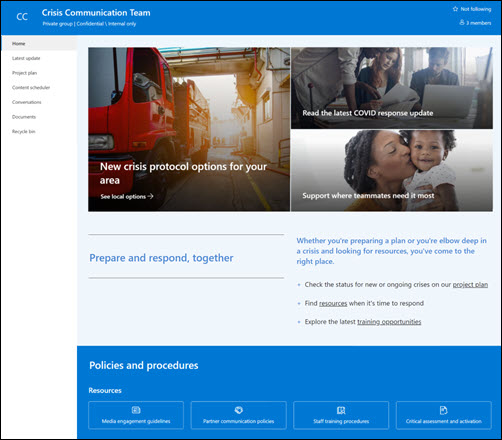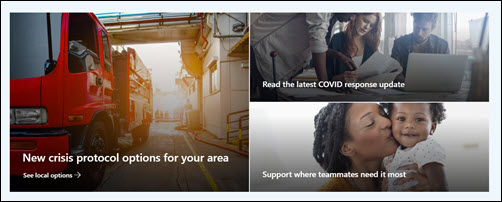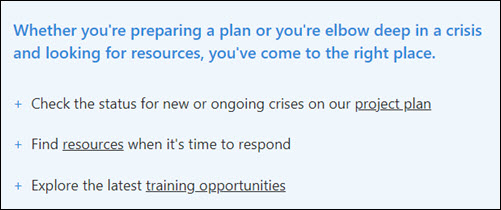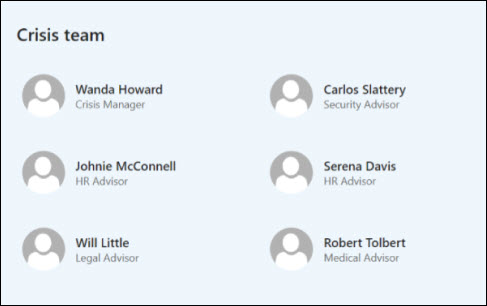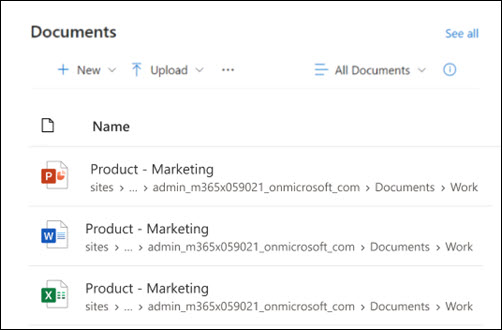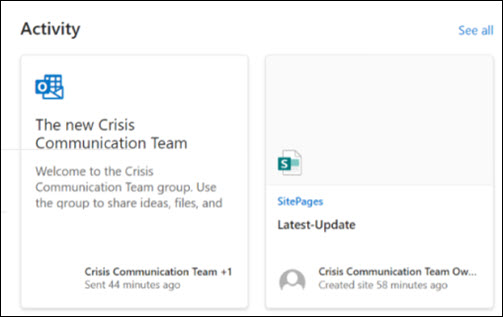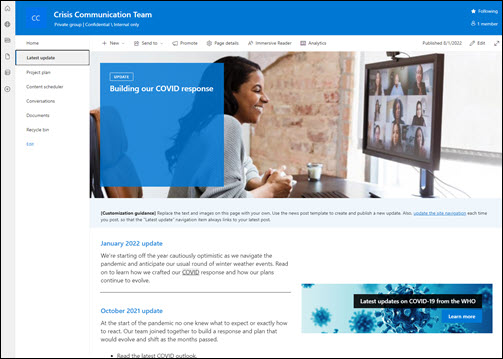The SharePoint Crisis communication team site template is a team site designed to serve as an internal home page for your crisis communication team. Coordinate and plan event details with your team while keeping everyone informed.
In this article, we share the elements that are on the SharePoint Crisis communication team site template and discuss how you can customize the site to make it your own.
Notes:
-
This template is a Microsoft 365 connected template. When a team is created using this template, the connected SharePoint template is applied to the site and the team.
-
SharePoint components such as pages, lists, and Power Platform integrations are automatically added and pinned as tabs to the General channel in the team. Users can edit these pages and lists right from within Teams.
Site features
-
Customizable site that comes with pre-populated with images, web parts, and content that's meant to inspire site editors when making customizations to fit the need of your team.
-
Use Microsoft Lists to create a project tracker and issues tracker list to help manage and track project details with your team.
Notes:
-
Some functionality is introduced gradually to organizations that have opted into the Targeted release program. This means that you may not yet see this feature, or it may look different than what is described in the help articles.
-
When you apply a template to an existing site, your content will not automatically merge with the new template. Instead, existing content will be stored as a duplicate page in Site contents.
First, follow instructions on how to add a site template to a new or existing SharePoint site.
Note: You must have site creation permissions to add this template to your site.
Explore pre-populated site content, web parts, and pages and decide what site customizations will be necessary to align with your organization's brand, voice, and overall business objective.
Pre-populated site pages:
-
Home page - Provides and landing place for visitors to review news on ongoing crises, response updates, information on policies and procedures, and helpful resources.
-
Latest update - This page provides space for you to share current news and updates relating to crises and your organization.
-
Project plan – Keep track of all work progress related to upcoming projects. Customize this list template by editing list text fields.
-
Content scheduler – Organizes content that will be shared regarding upcoming events. Customize this list by editing the list template.
-
Conversations - Connects to a shared team alias and team calendar in Outlook. Connect this site to a Microsoft 365 group to add real time chat in Microsoft Teams.
-
Documents - Connects to a shared team alias and team calendar in Outlook. Connect this site to a Microsoft 365 group to add real-time chat in Microsoft Teams.
-
Recycle bin - Provides access to recently discarded team content.
Once you've added the Crisis communication team site template, it's time to customize it and make it your own.
Note: To edit a SharePoint site you must be a site owner or site member.
|
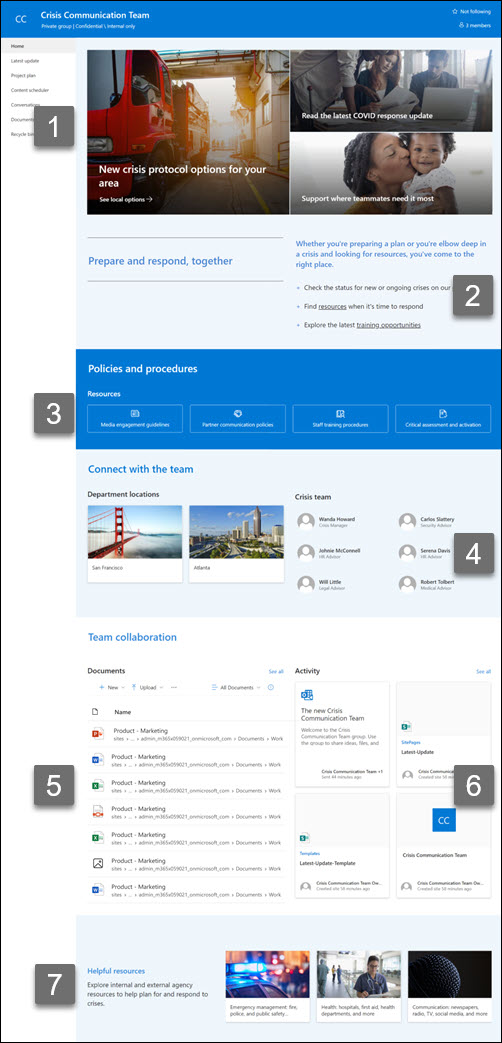 |
Customize your site's look, site navigation, web parts, and content to fit the needs of your viewers and of the organization. When making customizations, ensure the site is in edit mode by selecting Edit in the top right of the site. As you work, Save as a draft, or Republish changes to make edits visible to viewers.
1. Use the Hero web part to highlight crisis protocols, situational updates, and useful resources
-
Begin by selecting the Hero web part and select Edit properties (
-
Then, select the Layer and Tile options that best suit the organization’s needs.
See different layouts and learn more about editing the Hero web part.
2. Use the Text web part to provide the team with helpful information
-
Begin by selecting the Text web part and select Edit properties (
-
Edit your text directly in the web part.
Learn more about editing the Text web part.
3. Use the Quick links web part to provide easy access to crisis resources
-
Navigate to the Quick Links web part, select the link, and then select Edit properties (
-
Edit the link, title, icon, and description if needed.
-
To add a link, select + Add links.
See different layouts and learn more about editing the Quick Links web part.
4. Use the People web part to list key contacts for the crisis team
-
Start by deleting the placeholder People web part.
-
Find the Toolbox (
-
Select Edit properties (
-
Adjust the layout and enter the name of a person or group, then select Save.
Learn more about the People web part.
5. Use the Document library web part to provide quick access to departmental resources and documents
-
To change the view, or folder source for the Document library web part, select the Edit properties (
-
To edit document library folders, labels, content, navigate to library in Site content, make your edits, and then you see content update in the web part.
Learn more about editing the Document Library web part.
6. Use the Site activity web part to stay up to date on team activity
-
Begin by selecting the Site activity web part and select Edit properties (
-
Enter a number in the toolbox under Show this many items at a time.
Learn more about using the Site Activity web part.
7. Use the Quick links web part to curate a list of internal and external agency resources
-
Begin by selecting the Quick links web part and select Edit properties (
-
Edit the link, title, icon, and description if needed.
-
To add a link, select + Add links.
Learn more about using the Quick links part.
Customize the following pages within the site
-
Latest update - Provide updates on current crises and your team’s response. Customize this page by editing the Text and Call to action web parts.
-
Project plan - Track any issues that may get in the way of the project. Customize this list template by editing list text fields.
-
Content scheduler - Organizes content that will be shared leading up to events. Customize this list by editing the list template.
Customize the look and site navigation
Before you share your site with others, put the finishing touches on your site by ensuring users can find the site, navigate through links and pages easily, and quickly access content on the site.
-
Edit document libraries by updating the folder names and uploading resources.
-
Edit and customize site navigation.
-
Change the look of your site by customizing the theme, logo, header layouts, and the look of your site.
-
Add or remove pages to this site or the site navigation to accommodate existing content.
-
Choose to associate this site with a hub site within your organization, or add this site to an existing hub site navigation if needed.
Share your site with others after you've customized your site, reviewed it, and published the final draft.
-
Select Settings and then Site Permissions.
-
Then select Invite people and then select Add members to group and then Add to grant full access to team site content, shared resources like the team Outlook calendar and editing rights to the site.
-
Then select Invite people and then Share site only and then Save to share the site but not shared resources or site editing rights.
Learn more about managing team site settings, site information and permissions.
After you create and launch your site, the next important phase is maintaining site content. Ensure you have a plan to keep content and web parts up to date.
Site maintenance best practices:
-
Plan for site maintenance - Establish a schedule to review the site content as often as needed to ensure content is still accurate and relevant.
-
Regularly post news - Distribute the latest announcements, information, and status across the organization. Learn how to add a News post on a team site or communication site, and show others who will be posting announcements how they can use SharePoint news.
-
Check links and web parts - Keep links and web parts updated to ensure you are leveraging the full value of your site.
-
Use analytics to improve engagement - View site usage by using the built-in usage data report to get information on popular content, site visits, and more.
-
Periodically review your site settings - Once you've created a site in SharePoint, you can make changes to the settings, site information, and permissions for the site.
More customization resources
Learn more about planning, building, and maintaining SharePoint sites.
See more SharePoint site templates.

